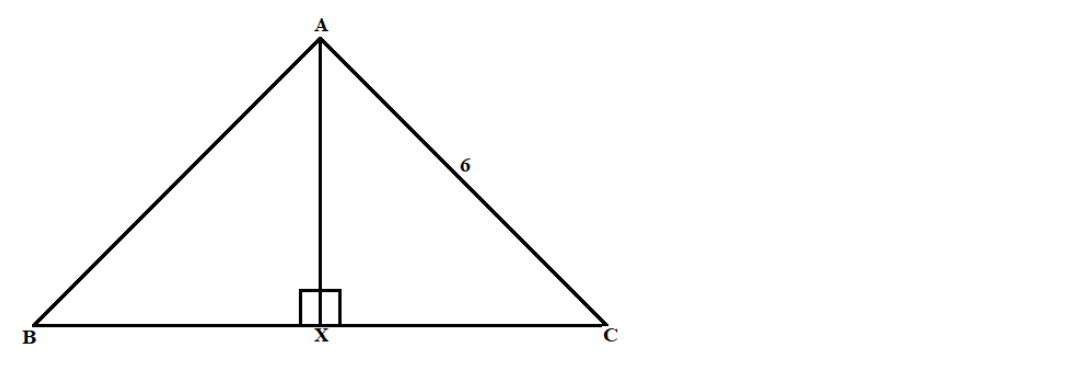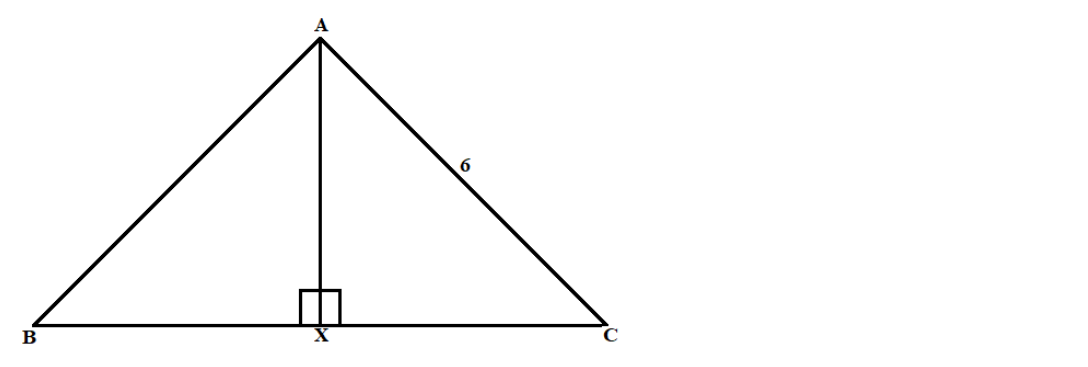
The figure below is an equilateral triangle with sides of length 6. What is the area of the triangle?

A. 12
B. 18
C. 36
D. ${\text{9}}\sqrt {\text{3}} $

Answer
574.8k+ views
Hint: As the given triangle is equilateral, we can use the concept of trigonometry to find the area of the equilateral triangle, we use the formula of \[{\text{sinC}}\]where \[\angle {\text{C = 60$^\circ$ }}\] to get the length of altitude, then we use the formula of area of triangle i.e. ${\text{Area = }}\dfrac{{\text{1}}}{{\text{2}}}{\text{ $\times$ base $\times$ height}}$, and hence we get the required answer.
Complete step by step answer:
We are given an equilateral triangle ABC with side length 6 units. We are also given an altitude of the triangle AX.

Consider the right-angled triangle AXC. We can use trigonometry to get,
${\text{sinC = }}\dfrac{{{\text{AX}}}}{{{\text{AC}}}}$
As ABC is a right triangle, \[\angle {\text{C = 60$^\circ$ }}\] and AC= 6, we get
${\text{sin60 = }}\dfrac{{{\text{AX}}}}{{\text{6}}}$
After rearranging, we get
${\text{AX = 6 $\times$ sin60}}$
We use the value of \[{\text{sin6}}{{\text{0}}^{\text{o}}}{\text{ = }}\dfrac{{\sqrt {\text{3}} }}{{\text{2}}}\], we get,
\[{\text{AX = }}\dfrac{{6\sqrt {\text{3}} }}{{\text{2}}}\]
Using the altitude and base in the equation to find the area, we get,
$
{\text{Area = }}\dfrac{{\text{1}}}{{\text{2}}}{\text{ $\times$ AX $\times$ BC}} \\
{\text{ = }}\dfrac{{\text{1}}}{{\text{2}}}{\text{ $\times$ }}\dfrac{{{\text{6}}\sqrt {\text{3}} }}{{\text{2}}}{\text{ $\times$ 6}} \\
$ On simplification, we get,
${\text{Area = 9}}\sqrt {\text{3}} $
Therefore, the area of the triangle is ${\text{9}}\sqrt {\text{3}} $ square units
Hence, the correct answer is option D.
Note: The concept of trigonometry is used in this problem. Trigonometric ratios and their values at common angles must be known. We can also find the area using the direct equation ${\text{A = }}\dfrac{{\sqrt {\text{3}} }}{{\text{4}}}{{\text{a}}^{\text{2}}}$, where a is the side of equilateral triangle.
An alternate method to find the height of the triangle is by using Pythagoras theorem.
Consider the right-angled triangle AXC,
By Pythagoras theorem,
$A{X^2} + X{C^2} = A{C^2}$
We are given $AC = 6$ and AX is the height h.
We know that the altitude of an equilateral triangle bisects the side. So, we can write $XC = \dfrac{a}{2} = \dfrac{6}{2} = 3$
Substituting these values in Pythagoras theorem, we get,
${h^2} + {3^2} = {6^2}$
$ \Rightarrow {h^2} + 9 = 36$
$
\Rightarrow {h^2} = 36 - 9 \\
\Rightarrow {h^2} = 27 \\
$
Taking the positive square root, we get.
$h = \sqrt {27} = \sqrt {3 \times 3 \times 3} $
$ \Rightarrow h = 3\sqrt 3 $
Using the altitude and base in the equation to find the area, we get,
$
{\text{Area = }}\dfrac{{\text{1}}}{{\text{2}}}{\text{ $\times$ h $\times$ a}} \\
{\text{ = }}\dfrac{{\text{1}}}{{\text{2}}}{\text{ $\times$ 3}}\sqrt {\text{3}} {\text{ $\times$ 6}} \\
$
On simplification, we get,
${\text{Area = 9}}\sqrt {\text{3}} $
Complete step by step answer:
We are given an equilateral triangle ABC with side length 6 units. We are also given an altitude of the triangle AX.

Consider the right-angled triangle AXC. We can use trigonometry to get,
${\text{sinC = }}\dfrac{{{\text{AX}}}}{{{\text{AC}}}}$
As ABC is a right triangle, \[\angle {\text{C = 60$^\circ$ }}\] and AC= 6, we get
${\text{sin60 = }}\dfrac{{{\text{AX}}}}{{\text{6}}}$
After rearranging, we get
${\text{AX = 6 $\times$ sin60}}$
We use the value of \[{\text{sin6}}{{\text{0}}^{\text{o}}}{\text{ = }}\dfrac{{\sqrt {\text{3}} }}{{\text{2}}}\], we get,
\[{\text{AX = }}\dfrac{{6\sqrt {\text{3}} }}{{\text{2}}}\]
Using the altitude and base in the equation to find the area, we get,
$
{\text{Area = }}\dfrac{{\text{1}}}{{\text{2}}}{\text{ $\times$ AX $\times$ BC}} \\
{\text{ = }}\dfrac{{\text{1}}}{{\text{2}}}{\text{ $\times$ }}\dfrac{{{\text{6}}\sqrt {\text{3}} }}{{\text{2}}}{\text{ $\times$ 6}} \\
$ On simplification, we get,
${\text{Area = 9}}\sqrt {\text{3}} $
Therefore, the area of the triangle is ${\text{9}}\sqrt {\text{3}} $ square units
Hence, the correct answer is option D.
Note: The concept of trigonometry is used in this problem. Trigonometric ratios and their values at common angles must be known. We can also find the area using the direct equation ${\text{A = }}\dfrac{{\sqrt {\text{3}} }}{{\text{4}}}{{\text{a}}^{\text{2}}}$, where a is the side of equilateral triangle.
An alternate method to find the height of the triangle is by using Pythagoras theorem.
Consider the right-angled triangle AXC,
By Pythagoras theorem,
$A{X^2} + X{C^2} = A{C^2}$
We are given $AC = 6$ and AX is the height h.
We know that the altitude of an equilateral triangle bisects the side. So, we can write $XC = \dfrac{a}{2} = \dfrac{6}{2} = 3$
Substituting these values in Pythagoras theorem, we get,
${h^2} + {3^2} = {6^2}$
$ \Rightarrow {h^2} + 9 = 36$
$
\Rightarrow {h^2} = 36 - 9 \\
\Rightarrow {h^2} = 27 \\
$
Taking the positive square root, we get.
$h = \sqrt {27} = \sqrt {3 \times 3 \times 3} $
$ \Rightarrow h = 3\sqrt 3 $
Using the altitude and base in the equation to find the area, we get,
$
{\text{Area = }}\dfrac{{\text{1}}}{{\text{2}}}{\text{ $\times$ h $\times$ a}} \\
{\text{ = }}\dfrac{{\text{1}}}{{\text{2}}}{\text{ $\times$ 3}}\sqrt {\text{3}} {\text{ $\times$ 6}} \\
$
On simplification, we get,
${\text{Area = 9}}\sqrt {\text{3}} $
Recently Updated Pages
Master Class 9 Social Science: Engaging Questions & Answers for Success

Master Class 9 Science: Engaging Questions & Answers for Success

Master Class 9 English: Engaging Questions & Answers for Success

Master Class 9 Maths: Engaging Questions & Answers for Success

Master Class 9 General Knowledge: Engaging Questions & Answers for Success

Class 9 Question and Answer - Your Ultimate Solutions Guide

Trending doubts
Which places in India experience sunrise first and class 9 social science CBSE

Fill the blanks with the suitable prepositions 1 The class 9 english CBSE

Write the 6 fundamental rights of India and explain in detail

Difference Between Plant Cell and Animal Cell

What is pollution? How many types of pollution? Define it

What is the Full Form of ISI and RAW




